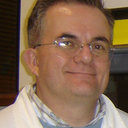Solid-phase microextraction (SPME) analysis of six Italian populations of Ephedra nebrodensis Tineo ex Guss. subsp. nebrodensis.
キーワード
概要
Headspace solid-phase microextraction (HS-SPME) coupled with GC/FID and GC/MS was applied for the first time in the analysis of the volatile fraction of an Ephedra species. Notably, six Italian populations (Marche, Abruzzo, and Sardinia) of Ephedra nebrodensis subsp. nebrodensis, covering almost the entire Italian area, were investigated to examine the chemical variability and to support the taxonomy of the species. A fiber screening with polymethylsiloxane (PDMS), Carboxen(TM) /polymethylsiloxane (CAR/PDMS), and polymethylsiloxane/divinylbenzene (PDMS/DVB) coatings, together with an optimization of the extraction conditions were carried out before analysis of the six populations. A total of 119 volatiles were identified in the headspace of different samples, accounting for 63.35-100.00% of the total volatiles. A great variability was found in the qualitative composition of different samples, since only 18 components were in common among all populations. The headspace composition was dominated by sesquiterpene hydrocarbons (52.30-88.32%), with β-maaliene (traces-7.49%), β-patchoulene (traces-1.29%), β-panasinsene (traces-6.85%), α-isocomene (traces-31.25%), α-trans-bergamotene (traces-6.95%), alloaromadendrene (traces-33.20%), α-acoradiene (traces-9.41%), and γ-muurolene (0.61-16.33%) being the most abundant constituents. Noteworthy is the occurrence in a sample of two major unknown sesquiterpenes, one hydrocarbon (24.49%, RI: 1396) and one oxygenated compound (10.37%, RI: 1591), whose mass spectra were reported for the first time. Multivariate chemometric techniques, such as cluster analysis (CA) and principal component analysis (PCA), were used to characterize the samples according to the geographical origin.



